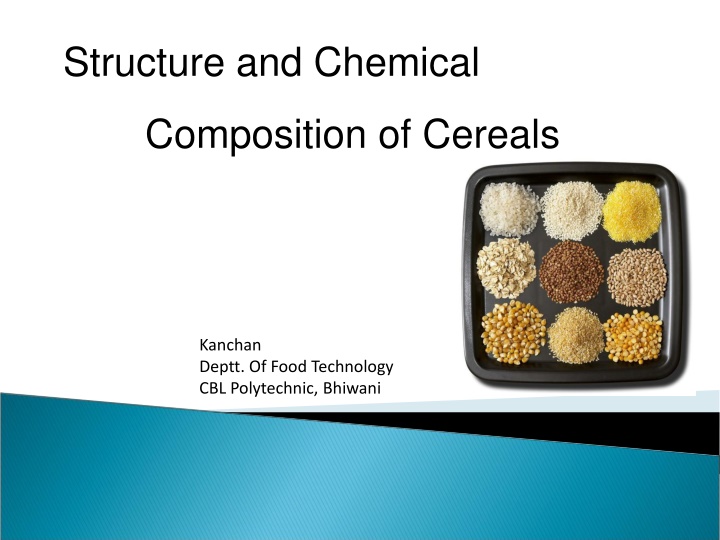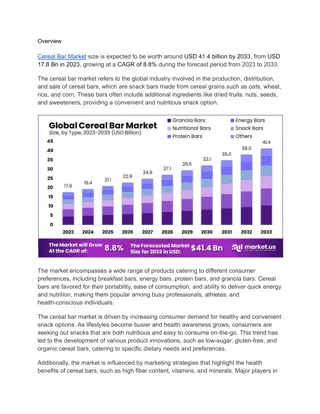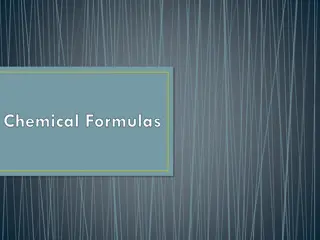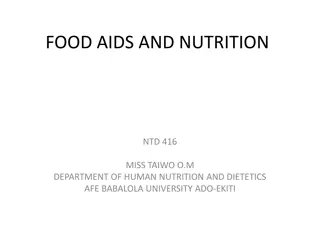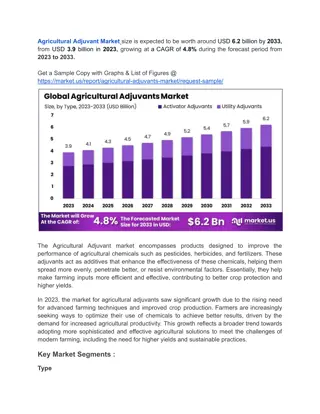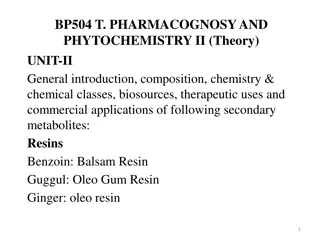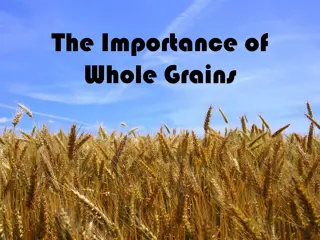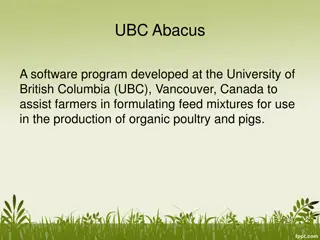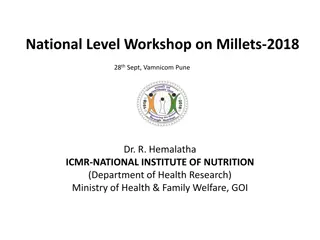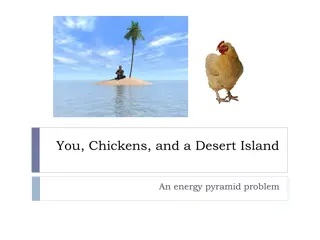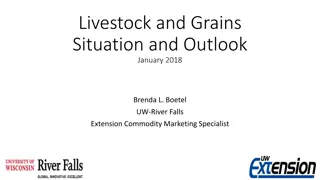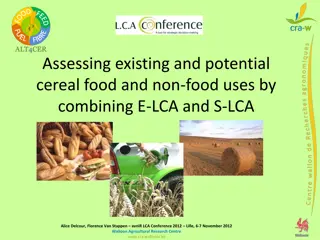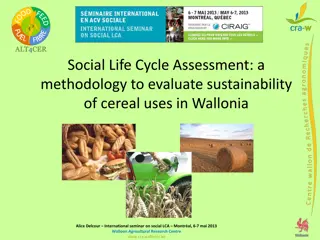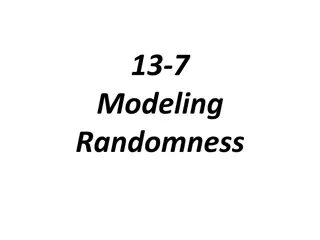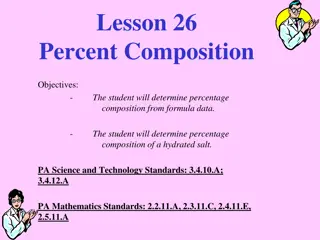Structure and Chemical Composition of Cereal Grains: A Detailed Overview
Cereals, belonging to the grass family, have unique properties making them essential in various diets worldwide. This article delves into the structures and chemical compositions of popular cereal grains like wheat, barley, rice, maize, and oats. Wheat, a staple food, is categorized into different species based on protein content and intended use, such as for bread, pasta, and baked goods. Understanding the distinctions between types of wheat, be it hard or soft, red or white, aids in selecting the appropriate variety for specific culinary purposes.
Download Presentation

Please find below an Image/Link to download the presentation.
The content on the website is provided AS IS for your information and personal use only. It may not be sold, licensed, or shared on other websites without obtaining consent from the author.If you encounter any issues during the download, it is possible that the publisher has removed the file from their server.
You are allowed to download the files provided on this website for personal or commercial use, subject to the condition that they are used lawfully. All files are the property of their respective owners.
The content on the website is provided AS IS for your information and personal use only. It may not be sold, licensed, or shared on other websites without obtaining consent from the author.
E N D
Presentation Transcript
Structure and Chemical Composition of Cereals Kanchan Deptt. Of Food Technology CBL Polytechnic, Bhiwani
Structure & composition of cereal grains Wheat Barley Rice Maize (corn), Oats
Cereals Belongs to gramineae (grass) family Seed is commonly called as grain/ caryopsis Main CHO source in many nations diet Each cereal has unique properties which make it suitable for a variety of food products Cereals require different conditions to grow. Ex: rice - tropical climates, oats cold temperate
1. Wheat Wheat (Triticum spp.) is a grass that is cultivated temperate zone. The most important human food grain and ranks second in total production as a cereal crop behind maize; the third being rice Wheat grain is a staple food used to make flour for breads; cookies, cakes, pasta, noodles.
Common Species of wheat :- Triticum aestivum Common wheat T. monococcum T. vulgare T. dicoccum has certain disease resistance qualities Triticum compactum Two types; white & red varieties T. durum/ Durum wheat/ Macaroni wheat has a hard, translucent, light colored endosperm which makes it suitable as an ingredient for pasta
Common bread wheat can be categorized as: Hard / Soft varieties Spring / winter varieties White / red varieties Hard Red Spring Hard, brownish, high protein wheat used for bread and hard baked goods - use to make bread Flour and high gluten flours Hard Red Winter Hard, brownish, high protein wheat used for bread, hard baked goods and as an adjunct in other flours to increase protein in pastry flour -use to prepare some brands of unbleached all- purpose flours
Soft Red Winter Soft, low protein wheat used for cakes, pie crusts, biscuits. - use to make cake flour, pastry flour, and some self- rising flours Hard White Hard, light colored, opaque, chalky, medium protein wheat planted in dry, temperate areas - Used for bread and brewing. Soft White Soft, light colored, very low protein wheat grown in temperate moist areas - Used for pie crusts and pastry. Hard wheats are harder to process and red wheats may need bleaching. So, soft and white wheats usually have higher prices than hard and red wheats on the commodities market.
Raw wheat seed - wheat food ingredient called whole can be powdered into flour, germinated and dried creating malt, crushed cracked wheat, parboiled (or steamed), dried, or processed into semolina, pasta and de-branned into These processed wheat are a major ingredient in such foods as bread, breakfast cereals, crackers, biscuits, pancakes & cakes
Structure of the wheat grain: Wheat grains - generally oval shaped ( range from spherical to long, narrow and flattened shapes) 5 and 9mm in length, weighs between 35 and 50mg Wheat grain has a crease down one side where it was originally connected to the wheat flower.
Wheat grain, showing different sides and cross section to illustrate the depth of the crease
Pericarp Outer pericarp Inner pericarp Grain Seed coat (Testa) Seed Endosperm Aleurone layer Germ
Pericarp outer most cover outer pericarp consists of 3 layers epidermis hypodermis Inner thin walled cell Inner pericarp consists of Intermediate cells cross cell Tube cell
Seed coat firmly attached to the tube cells if these layer carries pigments, kernel is colorful Aleurone layer Outer most layer of the endosperm which contains vitamin B
The three main parts are: 1. Bran outer layers of the wheat grain; removed during milling About 14% of the wheat kernel The outer coating or 'shell' of the wheat kernel is made up of several layers These layers protect the main part of the kernel Bran is rich in B vitamins and minerals Wholemeal flour contains all the naturally occurring bran.
2. Endosperm main part of the wheat kernel or name given to the interior of a wheat kernel represents about 80% of the kernel weight The endosperm, once it has been ground down to a powder, is wheat flour It is from this part that white flour is milled. The endosperm is rich in energy-yielding carbohydrate and important protein.
3. Germ (Embryo) part of the grain which would sprout if it was planted as a seed packed with nutrients and protein with which to nourish a new plant During milling the germ is usually separated from the rest of the wheat grain ( fat content limits the shelf life of the flour) The germ lies at one end of the grain and represents only 2% of the kernel rich source of B vitamins, oil, vitamin E and natural plant fat.
Rice (Oryza sativa) most important cereal crop in developing world staple food of over half the world's population production is only slightly below that of wheat 90% is grown in southern & eastern Asian Grain structure consists of an outer protective covering, the hull, and the rice caryopsis or fruit Brown rice consists of the outer layers of pericarp, seed-coat and nucellus; the germ or embryo; and the endosperm
Endosperm consists of the subaleurone layer and starchy endosperm. The aleurone layer encloses the embryo The hull constitutes about 20 % of the rough rice weight. The distribution of brown rice weight: Pericarp 1 - 2 % Aleurone, nucellus, seed-coat 4 - 6% Germ 1 % Scutellum 2 % Endosperm 90 - 91 %
The endosperm cells : thin-walled and packed with starch granules The two outermost cell layers are rich in proteins and lipids have the inner endosperm. smaller amyloplasts & starch granules than starch granules are polyhedral and mainly 3 - 9 m in size Protein protein bodies occurs mainly in the form of spherical
Chemical composition of rice grain Hulled rice Rice bran Water 10 12% Water Protei 8.9 12.5% Protein 5 9% 10.6 14.8% Fat 0.6 2.6% n Fat 10.6 22.4% CHO 73 90% Fiber 9.6 11.1% Fiber 0.2 1% Ash 9.3 15% Ash 0.8 - 2%
Rye Chemical & physical characteristics -The rye kernel is a caryopsis. - Caryopsis is a small dry, indehiscent, one seeded fruit. -6 8 mm in length & 2 3 mm in width. -The color is normally grayish yellow -The seed consists of an embryo attach through a scutellum to the endosperm & Aleurone layer
-The pericarp or fruit coat surrounds the whole seed & adhere closely to it. -A crease or furrow extends the full length of the grain on the ventral side -The nutritional quality of rye protein - superior to that of other cereals because of its better balance of EAA. -Its protein efficiency ratio seems to be higher due to; - the greater amount of lysine present in the water soluble proteins & the higher proportion of globulin & albumin
-Rye lipids differ from those of most other cereals by having a slightly greater proportion of the highly unsaturated linolenic acid. -Therefore susceptible to oxidation. cause rancidity -Starch granules have a mean particle diameter greater than those of other cereals lenticular shape -shape spherical shape
-8% pentosans in rye (in wheat is 3%) -rye bread has large pores & moisture than wheat bread -Rye has few micronutrients; Thiamine Nicotinic acid Riboflavin Pyridoxin Pantothenic acid Tocopherol
Oats(Avenea sativa) -grown in cooler & moisture regions of the temperate zones -varieties ored oats heat tolerant southern US, South America, Australia Winter oats planted in the late fall, latitude of 20 - 400 Spring oats planted when the threat of frost is minimum
- used to prepare cakes, biscuits, & breakfast cereals -The physical structure of the oat grain is similar to that of kernel of wheat & barley - The 3 major divisions - Bran - Endosperm - Germ -The oat germ is larger & narrower than the germ of wheat -Compared characterized by low CHO contents & higher protein & fat content to other cereals oat grains are
Barley Genus: Hardeum Most of the cultivated barley classified in to two groups 1. H. vulgare six rowed barley 2. H. distictum two rowed barley Structure of Barley kernel The caryopsis is composed of Pericarp Integuments Starchy endosperm Germ
-The outer layer of endosperm is made out of aleurone cells -In blue barley, blue color is due to color given by the anthocynin pigments in alkaline aleurone cells Composition of barley Protein 12% CHO 70% Mineral 2%
-Low in EAA esp lysine & Methionine -Have more lysine than corn -Contains larger amount of vitamin compared to corn Large granules(A) -Barley granules Small granules(B) Large granules(A) - contain high amylopectin -have lower gelatinization tem small granules(B) -contain low amylopectin -have higher gelatinization tem
There are two major groups of protein 1.Glutelins & Prolamins 2.Albumins & globulins Uses 1.source of malt in manufacture of alcohols, wisky, beer 2.use as a flavoring agent in breakfast cereals, malted milk, infant foods, medicinal syrups
Sorghum (Sorghum vulgare ) -Staple food in drier part of tropical Africa, china, India -Native home is Africa -The grains are differently colored Yellow, Red, or Brown Composition Fat 3% CHO 70% Fiber 12%
Millets -Common term used to large number of cultivated grasses with very small seeds -Used as forage & as a food for both man & domestic animals -More important in the East than West -Generally known as poor man s cereal
1. Fortail millets ( Setaria italica) -Grown in Japan, China, India grains are boiled eaten -In North America - mainly used as a forage crop 2. Proso millet (Panicum miliaceum) Contains 10 % proteins, 4 % Fat - A palatable bread can be made from these 3.Finger millet (Eleusine coracana) - Grown mainly in the tropics -Most important cereal crop in chena in Sri Lanka
Maize (Zea mays) -Originated in low land of tropical SouthAmerica -Leading producers : USA, China, Russia, India, Italy Kind of maize: Cultivars are divided in to groups, according to structure of grains 1.Pod corn Zea mays var. tunicata -Most primitive form -not grown commercially
2. Popcorn Zea mays var. everta -Grains small with a little soft starch at the center -When heating cause the grains to pop Flint corn Zea mays var. indurate 3. -Grains with hard endosperm -A little, soft starch in the center -Well adopted to poultry feed Dent corn Zea mays var. indentata 4. -Principle maize of US & North mexico -White starch shrinks on drying to produce a characteristic dent
5. Sweetcorn Zea mays var. saccharata - Grain consist a glossy sweetish endosperm - Cobs are picked immature for boiling as corn on the cobs - Also use as a vegetable by canning or freezing Flour corn Zea mays var. amylacea 6. - Endosperm consists with soft starch Waxy corn Zea mays var. ceratina 7. - Starch is waxy & composed of entirely of amylopectin
